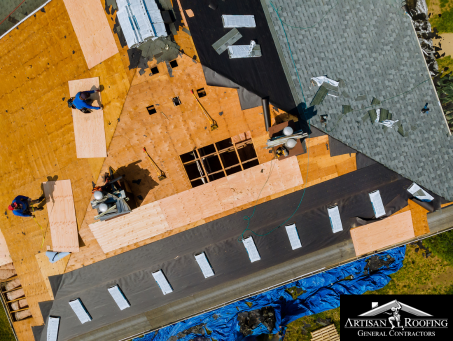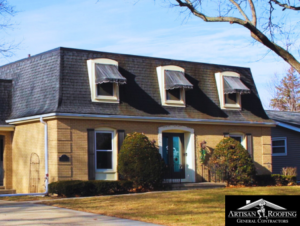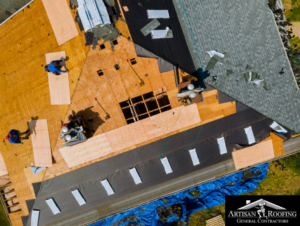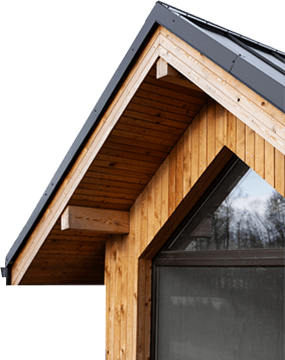When thinking about roof repairs or replacement, many homeowners overlook one vital component: roof decking. Also known as roof sheathing, roof decking forms the core of a roofing system, providing structural support, durability, and a foundation for other roofing materials.
Whether you’re planning a roof replacement, performing maintenance, or simply trying to learn more about your roof, understanding roof decking is key to making informed decisions. This guide covers everything you need to know, from types of roof decking and their costs to best practices for installation, maintenance, and energy efficiency.
Understanding Roof Decking: What It Is and Why It Matters
Roof decking refers to the layer of wood boards or panels attached to the roof’s structural framework, forming the base for shingles or other roofing materials. Roof decking plays an essential role in ensuring a solid, stable surface that protects your home.
Without reliable roof decking, shingles and other roofing materials wouldn’t have adequate support, leading to leaks, structural damage, and higher energy bills.
Quality roof decking keeps your roofing system sturdy, provides insulation, and helps roofs withstand the weight of snow, rain, and other elements.
Types of Roof Decking: Finding the Right Fit for Your Roof
There are two main types of roof decking: plank decking and sheet decking. Choosing the right type can depend on your budget, aesthetic preference, and the demands of your local climate.
Plank Decking
Plank decking consists of long wooden boards, typically measuring 1×6 or 1×8 inches, and is most common in older homes. Hand-cut for precision, plank decking gives a home an authentic, rustic look, but it may need reinforcement if the roof’s load-bearing demands are high.
Though rare in new constructions, plank decking remains an attractive choice for traditional aesthetics.
Sheet Decking
Sheet decking is the go-to choice for modern roofs and comes in two types: plywood and oriented strand board (OSB).
- Plywood. Plywood is constructed from thin wood layers bonded together, resulting in a material known for strength, durability, and moisture resistance.
Available in multiple thicknesses, it’s an ideal choice for roofs that face severe weather, as it provides solid support against wind, snow, and impact.
- Oriented Strand Board (OSB). OSB is made from compressed wood chips and resin. OSB is widely used due to its affordability, availability, and performance.
While it’s not as moisture-resistant as plywood, it’s strong enough to handle typical roofing applications and is easier to install.
Recognizing When to Replace Roof Decking
Signs of deterioration, such as sagging, warping, or rot, indicate it’s time to replace roof decking. If roof decking is damaged, it compromises the stability of the entire roof.
During a roof replacement, contractors typically assess the condition of the decking after stripping off old roofing materials. Any signs of damage mean the affected boards should be replaced to ensure a stable base for new roofing.
Costs of Roof Decking: Budgeting for Quality and Longevity
The cost of roof decking depends on the material chosen, local wood prices, and labor requirements. Plank decking usually costs more due to labor intensity, whereas OSB offers a more budget-friendly alternative.
For plywood and OSB, thickness and quality might impact the price. Generally, thicker plywood or moisture-resistant OSB costs more but offers better durability, especially in regions with extreme weather. While wood prices can fluctuate, selecting high-quality decking can help prevent future repair costs.
Choosing the Best Plywood for Roofing
Choosing the correct thickness and type of plywood is crucial. Standard roofing plywood thickness ranges from ⅜ inch to ¾ inch, with thicker options providing extra support and durability. In areas with heavy snowfall or storms, thicker plywood can help your roof withstand these challenges.
Moisture-resistant plywood is also worth the investment for added protection against mold, rot, and other moisture-related issues.
Benefits of High-Quality Roof Decking
Well-installed roof decking provides numerous advantages, including:
- Structural Support. Roof decking forms the base that holds shingles in place and distributes weight, protecting the roof from sagging or shifting.
- Weather Resistance. It serves as a buffer against wind, rain, and other elements, helping protect your home.
- Longevity. Quality decking extends the life of your roof by providing a sturdy foundation that prevents damage.
- Safety. Strong decking reduces the risk of leaks, roof collapse, or other hazards, keeping your home safe.
Best Practices for Roof Decking Installation
Proper installation is key to maximizing roof decking performance. Key practices include:
- Using the Right Nails. Secure the decking with roofing nails and follow the recommended nail pattern to prevent shifting or detachment.
- Ensuring Ventilation. Proper attic ventilation prevents moisture buildup, which can lead to rot and mold.
- Installing Moisture Barriers. Place underlayment between the decking and shingles to create a watertight layer that adds extra protection.
- Getting a Professional Assessment. A roofing contractor can assess your decking and recommend repairs or replacements as needed.
Tips for Roof Decking Maintenance
Roof decking doesn’t require much direct maintenance, but taking preventive steps can help extend its lifespan:
- Regular Inspections. Check for signs of damage like rot, sagging, or warping and address any issues promptly.
- Cleaning Gutters. Clogged gutters can cause water to back up, leading to potential damage to roof decking.
- Repairing Leaks. Fix any leaks as soon as possible to prevent water from seeping into the decking and causing rot.
- Trimming Trees. Prune branches near the roof to prevent debris buildup and reduce the risk of roof damage.
Roof Decking and Energy Efficiency: Reducing Energy Costs
Properly installed roof decking improves energy efficiency by providing a stable base for insulation and maintaining consistent indoor temperatures. By reducing heat transfer, roof decking can lower heating and cooling demands.
Choosing materials like moisture-resistant plywood or installing reflective coatings on decking in hot climates can further boost energy savings and contribute to a more comfortable living space.
Environmentally Friendly Choices for Roof Decking
Roof decking can impact your home’s sustainability, so consider eco-friendly materials. Look for decking made from FSC-certified wood or OSB that uses recycled wood chips.
By selecting materials sourced from responsibly managed forests, you reduce the environmental impact of your roof. Additionally, regular maintenance extends the life of the roof decking, reducing waste associated with frequent replacements.
Innovative Roof Decking Materials: Evolving for Greater Performance
The roofing industry is continually innovating. Modern engineered wood products offer improved strength, stability, and moisture resistance. Some advanced decking materials even come pre-treated to prevent rot and mold.
With technology advancing, new roof decking products are becoming more resilient, offering homeowners greater peace of mind and longer-lasting protection.
Professional Installation: Why Expertise Matters for Roof Decking
Installing roof decking requires knowledge of building codes, material selection, and technical skills. Hiring a professional roofing contractor ensures the decking is installed securely and meets safety standards.
Proper installation reduces the risk of structural issues, water damage, and other roofing problems. Pros also have access to quality materials and tools, ensuring a durable and dependable roofing foundation.
Avoiding Common Roof Decking Mistakes
Many common roof decking errors can compromise the integrity of your roof. Some of these mistakes include:
- Using the Wrong Material or Thickness. Inadequate thickness can lead to roof damage, especially in regions with heavy loads or extreme weather.
- Incorrect Nailing Patterns. Using the wrong nail pattern can result in shifting or loose boards.
- Neglecting Ventilation. Without proper attic ventilation, moisture can build up and lead to decking rot.
- Skipping Maintenance. Failing to address small issues can allow them to grow into costly repairs over time.
Roof Decking and Building Codes: Ensuring Safety and Compliance
Building codes are in place to protect homes from structural failure and ensure occupant safety. Local codes specify standards for materials, thickness, and installation methods. Roof decking must meet these requirements to pass inspections and avoid potential legal issues.
Working with a professional roofing contractor ensures that your roof decking complies with all relevant codes, protecting your home and investment.
Climate Considerations: Choosing the Right Roof Decking
Climate plays a significant role in selecting roof decking materials. Here are some tips based on regional needs:
- Cold Climates. Opt for thicker plywood or OSB and add extra insulation to help support the weight of snow and retain heat indoors.
- Humid Climates. Moisture-resistant decking materials are ideal, as they prevent rot and mold growth.
- Hot Climates. Choose decking materials that can withstand thermal expansion and consider reflective coatings to reduce heat absorption.
DIY vs. Professional Roof Decking Installation
While some home improvement tasks are suitable for DIY efforts, roof decking installation is best left to professionals. Precise measurement, accurate cuts, and secure attachment are critical for effective roof decking.
Professionals also understand building codes and ventilation requirements, ensuring that your roof decking is safe, reliable, and long-lasting.
The Foundation of a Strong Roof—Investing in Quality Roof Decking
Roof decking is more than just a hidden layer beneath your shingles; it’s the core structure that supports, stabilizes, and protects your entire roofing system. Without quality roof decking, even the most durable shingles or roofing materials will fail to provide the necessary protection against weather, temperature fluctuations, and the weight of debris, snow, or ice.
As you plan your roof replacement, repair, or new installation, recognizing the essential role of roof decking ensures you’re making decisions that will extend the life of your roof and provide a reliable defense against the elements.
Choosing the right roof decking—whether plank, plywood, or OSB—is a decision that depends on your budget, climate, and desired longevity. Opting for thicker, moisture-resistant materials, for example, can provide enhanced protection in areas prone to heavy snowfall or high humidity.
Even more, proper installation by experienced professionals helps to meet local building codes and ensures that the roof decking will perform optimally for decades to come.






